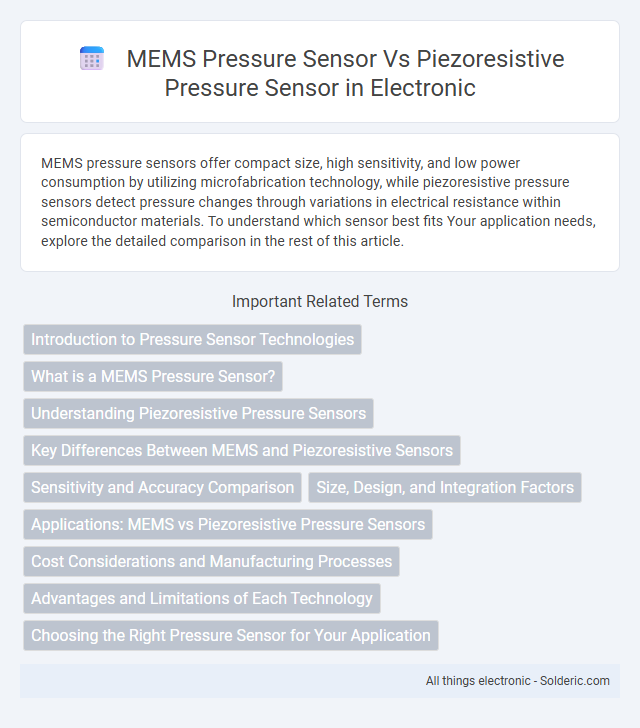MEMS pressure sensors offer compact size, high sensitivity, and low power consumption by utilizing microfabrication technology, while piezoresistive pressure sensors detect pressure changes through variations in electrical resistance within semiconductor materials. To understand which sensor best fits Your application needs, explore the detailed comparison in the rest of this article.
Comparison Table
| Feature | MEMS Pressure Sensor | Piezoresistive Pressure Sensor |
|---|---|---|
| Technology | Micro-Electro-Mechanical Systems, integrates mechanical elements with electronics | Resistance change in semiconductor material under mechanical stress |
| Sensitivity | High sensitivity with precise microfabrication | Moderate to high sensitivity depending on material |
| Size | Compact, microscale size ideal for embedded systems | Typically larger than MEMS sensors |
| Power Consumption | Low power consumption | Higher power compared to MEMS sensors |
| Accuracy | High accuracy with low drift | Good accuracy but prone to temperature variations |
| Application | Consumer electronics, automotive, medical devices | Industrial, automotive, pressure monitoring |
| Cost | Relatively cost-effective for large-scale production | Higher cost due to complex materials |
| Durability | Robust with good mechanical endurance | Durable but sensitive to mechanical fatigue |
Introduction to Pressure Sensor Technologies
MEMS pressure sensors utilize microelectromechanical systems technology to convert pressure changes into electrical signals with high sensitivity and miniaturization. Piezoresistive pressure sensors rely on the piezoresistive effect, where mechanical strain alters the resistance of semiconductor materials to measure pressure. Both technologies offer distinct advantages in precision, response time, and integration, making them suitable for diverse industrial and consumer applications.
What is a MEMS Pressure Sensor?
A MEMS pressure sensor is a micro-electromechanical system device that integrates mechanical sensing elements and electronics on a single silicon chip, enabling high precision and miniaturization. It measures pressure changes by detecting mechanical deformation of a diaphragm, typically using piezoresistive, capacitive, or piezoelectric sensing principles. Your choice of a MEMS pressure sensor offers benefits such as low power consumption, fast response, and suitability for compact, integrated applications.
Understanding Piezoresistive Pressure Sensors
Piezoresistive pressure sensors operate by measuring changes in electrical resistance caused by mechanical strain on a silicon element, offering high sensitivity and accuracy for pressure detection. Unlike general MEMS pressure sensors, which may use capacitive or piezoelectric principles, piezoresistive sensors are particularly effective in applications requiring precise pressure measurements under varying temperature conditions. Their integration into MEMS technology enables compact, reliable devices widely used in automotive, industrial, and medical applications.
Key Differences Between MEMS and Piezoresistive Sensors
MEMS pressure sensors integrate microfabricated structures with various sensing mechanisms, offering compact size, high sensitivity, and scalability for diverse applications. Piezoresistive pressure sensors specifically rely on the piezoresistive effect, where resistance changes under mechanical stress, providing accurate and linear response but with potential temperature sensitivity. The key differences lie in MEMS sensors' multifunctional design capabilities and broader application range versus piezoresistive sensors' singular focus on resistance-based pressure measurement and simpler fabrication.
Sensitivity and Accuracy Comparison
MEMS pressure sensors exhibit higher sensitivity due to their microfabricated structures enabling precise measurement of minute pressure changes, often achieving sensitivity in the range of 10 mV/kPa or better. Piezoresistive pressure sensors provide accurate readings with a linear response over a broad pressure range and sensitivities typically between 1 to 10 mV/V/kPa, but may suffer from temperature-induced drift affecting accuracy. Overall, MEMS sensors deliver superior sensitivity and stability, making them preferable for applications demanding high precision and minimal noise.
Size, Design, and Integration Factors
MEMS pressure sensors offer significantly smaller sizes compared to traditional piezoresistive pressure sensors, enabling compact and miniaturized device integration. The design of MEMS sensors often incorporates microfabrication techniques that allow for complex, highly sensitive structures while maintaining low power consumption. Integration factors favor MEMS sensors in applications requiring seamless incorporation with electronic circuits and system-on-chip (SoC) platforms due to their compatibility with semiconductor processes.
Applications: MEMS vs Piezoresistive Pressure Sensors
MEMS pressure sensors find extensive applications in automotive systems, medical devices, and consumer electronics due to their miniaturized design and low power consumption. Piezoresistive pressure sensors are preferred in industrial automation, aerospace, and heavy machinery for their high sensitivity and robustness under harsh conditions. Your choice depends on the application's specific demands for accuracy, size, and environmental resilience.
Cost Considerations and Manufacturing Processes
MEMS pressure sensors typically offer lower production costs due to batch fabrication techniques using semiconductor processes, enabling high-volume manufacturing with excellent consistency and miniaturization. Piezoresistive pressure sensors, while benefiting from established fabrication methods, often incur higher expenses stemming from individual calibration and packaging requirements that increase assembly complexity. The integration of MEMS technology reduces material waste and streamlines manufacturing, contributing to overall cost efficiency compared to traditional piezoresistive sensor production.
Advantages and Limitations of Each Technology
MEMS pressure sensors offer high sensitivity, compact size, and the ability to integrate with electronic circuits, making them ideal for applications requiring miniaturization and low power consumption; however, they can be sensitive to temperature variations and mechanical stress. Piezoresistive pressure sensors provide robust performance with a wide pressure range and good linearity, suitable for industrial and automotive uses, but they often consume more power and have slower response times compared to MEMS sensors. Both technologies trade off between sensitivity, size, power efficiency, and environmental resilience depending on the specific application requirements.
Choosing the Right Pressure Sensor for Your Application
MEMS pressure sensors offer compact size, low power consumption, and high sensitivity, making them ideal for portable and wearable devices. Piezoresistive pressure sensors provide robust performance and high accuracy in harsh environments, suitable for industrial and automotive applications. Your choice should depend on factors like required measurement range, environmental conditions, and integration needs to ensure optimal sensor performance.
MEMS pressure sensor vs piezoresistive pressure sensor Infographic

 solderic.com
solderic.com